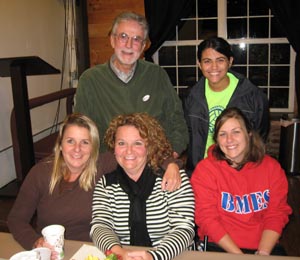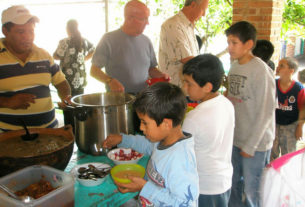Westwords

Really good things keep happening for San Quintin Escuela.
How this very rural elementary school has risen from nothing to something special is a stunning success story. The small Nayarit village in the foothills of the Sierra de Vallejo mountains, just 40 kilometers from downtown Puerto Vallarta, is a different world.
It is not distinctive and has been that way for generations.
Until Edd Bissell, by the grace of God or a quirk of fate, discovered the school and adopted it, nobody — nobody — had ever been beyond sixth grade. Today, a young woman is in her senior year of college architecture and several youth are in high school.
Good news travels slowly in Mexico but it has finally reached education officials in Mexico City.
A national study team is coming to San Quintin to investigate. What sparked this progress? How did it happen? One transplanted Tennessee redneck did it, you say? Could we use his ideas elsewhere?
There is another surprise. Five Tennessee teachers, specialists in English as a second language, heard about Uncle Edd and San Quintin and will give up spring vacations to be guest teachers for a week. They’ll pay their own way and help with whatever the local teacher says needs help.
Their March mission will be to stimulate additional learning. Their strengths? They are functional in Spanish and capable in a variety of subjects, math, science, geography, even volleyball.
Several years ago, I gave MexConnect readers some first impressions of the primary school in San Quintin:
Hard to find, on a back road, off the beaten path; rundown little building, one room, done up in drab cinderblock grey; one broken window and three broken chairs; never abandoned but long neglected.
Summary scene: Playground was littered and the basketball goal was bent down.
State officials in Tepic had obviously forgotten the school was there. Village parents passed it as they came and went but never gave it a first thought. There was generally a teacher and a few children attended, now and then, until they gave up on school and went to work.
The first minor miracle was how Bissell, now 74, found it. This former East Tennessee pharmacist and gentleman farmer, retired to Mexico, to the town of La Cruz de Huanacaxtle on the Bay of Banderas, to Punta Pelicanos to be precise, where the Pacific Ocean touches the soft-caramel sandy shore. His housekeeper, Patricia, missed her bus home and Edd fired up his big pickup for the drive. Along the way, Patricia pointed and said “That’s where I went to school.”
On the return trip, Edd stopped to look. It was a short jump to getting involved.
Patricia’s husband, Jose Alonso Reynoso Meza, was the second miracle. He said he would help.
Along came Luis Alberto Martinez Gomez, then 19. As an illegal immigrant, he had finished high school in California. He returned to Mexico with the idea of going to college. He went to school headquarters in Tepic and asked how to do it. He had no money.
He was offered a beginning teacher job and five days of instruction. He was assigned to San Quintin Escuela. That was minor miracle three.
Luis could speak English. Bissell explained that he, Alonso and others were committed to improving the school.
Bissell donated a laptop. Luis knew how to hook it up through a cell phone. Bissell suggested computerized learning programs. Luis knew where to get ’em (for free)
Luis implemented many Bissell ideas.
Bissell tapped into his network of friends and acquaintances for cash donations and other things that would strengthen the school. The response was amazing. One woman shipped in 57 books. San Quintin had its first library.
Bissell, through Alonso and Luis, persuaded village parents that education mattered, that it was much better to encourage children to stay in school instead of following tradition, girls getting pregnant and boys dropping out to get any odd job to help feed the family.
Bissell raised enough pesos to help it happen. He bought uniforms and paid bus fare for San Quintin “graduates” to attend the next level. There were conditions: accept responsibility, earn good grades and come back to give the younger children a boost.
The system is working. Other teachers have come and gone without disturbing the concept. Several parents are supporters. A youngster is now project treasurer. He keeps records and receipts — in a vault, in the home of the village godmother. It is a learning experience.
San Quintin Escuela is now 23rd in academic rank among some 1,100 schools in Nayarit. The one room is close enough to spotless. It is well equipped. There is indoor plumbing. Students do not drop cups or napkins on the grounds.
Tennessee teachers planning the academic mission are inspired.
“We are thrilled to be able to go to the school and meet the children and their families,” said Darby.
“I have a feeling we will gain more from the experience than the community will get from us. I believe it will change our lives. I know that we are dedicated to preparing great lessons.”
Jackie Hutto says the countdown to Mexico is exciting. She is gathering ideas. She works with 70 Spanish-speaking youngsters at her school — reading, writing, listening and speaking. She sometimes translates for parents.
She has considered the here-and-there differences between East Tennessee and Nayarit. Bissell is a lot of help. He says there are more cactus and mariachi bands in Mexico.

